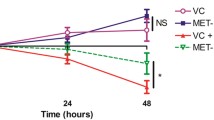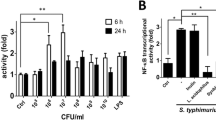Abstract
The intestinal mucosa contributes to frontline gut defenses by forming a barrier (physical and biochemical) and preventing the entry of pathogenic microbes. One innate role of the human colonic epithelium is to secrete cathelicidin, a peptide with broad antimicrobial and immunomodulatory functions. In this study, the effect of cathelicidin in the maintenance of epithelial integrity, Toll-like receptor recognition, bacterial invasion and initiation of inflammatory response against Salmonella typhimurium is investigated in cultured human colonic epithelium. We found exogenous human cathelicidin restores the epithelial integrity in S. typhimurium-infected colonic epithelial (T84) cells by mostly post-translational effects associated with reorganization of zonula occludens (ZO)-1 tight junction proteins. Endogenous cathelicidin prevents S. typhimurium internalization as shown in colonic epithelial cells genetically deficient in the only human cathelicidin, LL-37 (shLL-37). Moreover, supplementation of shLL-37 cells with synthetic LL-37 reduces the grade of S. typhimurium internalization in a dose-dependent manner. Mechanistically, shLL-37 cells have lower gene expression of TLR4 and pro-inflammatory cytokine IL-1β in response to S. typhimurium. Thus, human cathelicidin aids in the early colonic epithelial defenses against enteric S. typhimurium by preventing bacterial invasion and maintaining epithelial barrier integrity, likely to occur due to the production of sensing TLR4 and pro-inflammatory cytokines.





Similar content being viewed by others
References
Bai SP, Huang Y, Luo YH, Wang LL, Ding XM, Wang JP, Zeng QF, Zhang KY (2015) Effect of dietary nonphytate phosphorus content on ileal lymphocyte subpopulations and cytokine expression in the cecal tonsils and spleen of laying hens that were or were not orally inoculated with Salmonella Typhimurium. Am J Vet Res 76:710–718
Benincasa M, Pelillo C, Zorzet S, Garrovo C, Biffi S, Gennaro R, Scocchi M (2010) The proline-rich peptide Bac7(1-35) reduces mortality from Salmonella typhimurium in a mouse model of infection. BMC Microbiol 10:178
Bonnington KE, Kuehn MJ (2016) Outer membrane vesicle production facilitates LPS remodeling and outer membrane maintenance in Salmonella during environmental transitions. mBio 7(5). https://doi.org/10.1128/mBio.01532-16
Broz P, Newton K, Lamkanfi M, Mariathasan S, Dixit VM, Monack DM (2010) Redundant roles for inflammasome receptors NLRP3 and NLRC4 in host defense against Salmonella. J Exp Med 207:1745–1755
Broz P, Ohlson MB, Monack DM (2012) Innate immune response to Salmonella typhimurium, a model enteric pathogen. Gut Microbes 3:62–70
Cobo ER, Kissoon-Singh V, Moreau F, Holani R, Chadee K (2017) MUC2 mucin and butyrate contribute to the synthesis of the antimicrobial peptide cathelicidin in response to Entamoeba histolytica- and dextran sodium sulfate-induced colitis. Infect Immun 85(3). https://doi.org/10.1128/IAI.00905-16
Dharmsathaphorn K, McRoberts JA, Mandel KG, Tisdale LD, Masui H (1984) A human colonic tumor cell line that maintains vectorial electrolyte transport. Am J Phys 246:G204–G208
Durr UH, Sudheendra US, Ramamoorthy A (2006) LL-37, the only human member of the cathelicidin family of antimicrobial peptides. Biochim Biophys Acta 1758:1408–1425
Harish BN, Menezes GA (2015) Determination of antimicrobial resistance in Salmonella spp. Methods Mol Biol 1225:47–61
Hase K, Eckmann L, Leopard JD, Varki N, Kagnoff MF (2002) Cell differentiation is a key determinant of cathelicidin LL-37/human cationic antimicrobial protein 18 expression by human colon epithelium. Infect Immun 70:953–963
Iimura M, Gallo RL, Hase K, Miyamoto Y, Eckmann L, Kagnoff MF (2005) Cathelicidin mediates innate intestinal defense against colonization with epithelial adherent bacterial pathogens. J Immunol 174:4901–4907
Jung K, Eyerly B, Annamalai T, Lu Z, Saif LJ (2015) Structural alteration of tight and adherens junctions in villous and crypt epithelium of the small and large intestine of conventional nursing piglets infected with porcine epidemic diarrhea virus. Vet Microbiol 177:373–378
Kagambega A, Lienemann T, Frye JG, Barro N, Haukka K (2018) Whole genome sequencing of multidrug-resistant Salmonella enterica serovar Typhimurium isolated from humans and poultry in Burkina Faso. Tropical Med Health 46:4
Kawai T, Akira S (2011) Toll-like receptors and their crosstalk with other innate receptors in infection and immunity. Immunity 34:637–650
Kohler H, Sakaguchi T, Hurley BP, Kase BA, Reinecker HC, McCormick BA (2007) Salmonella enterica serovar Typhimurium regulates intercellular junction proteins and facilitates transepithelial neutrophil and bacterial passage. Am J Physiol Gastrointest Liver Physiol 293:G178–G187
Konig J, Wells J, Cani PD, Garcia-Rodenas CL, MacDonald T, Mercenier A, Whyte J, Troost F, Brummer RJ (2016) Human intestinal barrier function in health and disease. Clin Transl Gastroenterol 7:e196
Koon HW, Shih DQ, Chen J, Bakirtzi K, Hing TC, Law I, Ho S, Ichikawa R, Zhao D, Xu H, Gallo R, Dempsey P, Cheng G, Targan SR, Pothoulakis C (2011) Cathelicidin signaling via the toll-like receptor protects against colitis in mice. Gastroenterology 141(1852–1863):e1851–e1853
Kosciuczuk EM, Lisowski P, Jarczak J, Strzalkowska N, Jozwik A, Horbanczuk J, Krzyzewski J, Zwierzchowski L, Bagnicka E (2012) Cathelicidins: family of antimicrobial peptides. A review. Mol Biol Rep 39:10957–10970
Lee CW, Bennouna S, Denkers EY (2006) Screening for Toxoplasma gondii-regulated transcriptional responses in lipopolysaccharide-activated macrophages. Infect Immun 74:1916–1923
Marin M, Holani R, Shah CB, Odeon A, Cobo ER (2017) Cathelicidin modulates synthesis of toll-like receptors (TLRs) 4 and 9 in colonic epithelium. Mol Immunol 91:249–258
Meng D, Zhu W, Shi HN, Lu L, Wijendran V, Xu W, Walker WA (2015) Toll-like receptor-4 in human and mouse colonic epithelium is developmentally regulated: a possible role in necrotizing enterocolitis. Pediatr Res 77:416–424
Mogensen TH (2009) Pathogen recognition and inflammatory signaling in innate immune defenses. Clin Microbiol Rev 22:240–273 Table of Contents
Nadeau WJ, Pistole TG, McCormick BA (2002) Polymorphonuclear leukocyte migration across model intestinal epithelia enhances Salmonella typhimurium killing via the epithelial derived cytokine, IL-6. Microbes Infection / Institut Pasteur 4:1379–1387
Otte JM, Zdebik AE, Brand S, Chromik AM, Strauss S, Schmitz F, Steinstraesser L, Schmidt WE (2009) Effects of the cathelicidin LL-37 on intestinal epithelial barrier integrity. Regul Pept 156:104–117
Poppe C, Smart N, Khakhria R, Johnson W, Spika J, Prescott J (1998) Salmonella typhimurium DT104: a virulent and drug-resistant pathogen. Canadian Vet J 39:559–565
Raupach B, Peuschel SK, Monack DM, Zychlinsky A (2006) Caspase-1-mediated activation of interleukin-1beta (IL-1beta) and IL-18 contributes to innate immune defenses against Salmonella enterica serovar Typhimurium infection. Infect Immun 74:4922–4926
Rosenberger CM, Gallo RL, Finlay BB (2004) Interplay between antibacterial effectors: a macrophage antimicrobial peptide impairs intracellular Salmonella replication. Proc Natl Acad Sci U S A 101:2422–2427
Royston JP (1982) Algorithm AS 181: the W test for normality. J R Stat Soc Ser C (Applied Statistics) 31:176–180
Santos RL (2014) Pathobiology of salmonella, intestinal microbiota, and the host innate immune response. Front Immunol 5:252
Schaller-Bals S, Schulze A, Bals R (2002) Increased levels of antimicrobial peptides in tracheal aspirates of newborn infants during infection. Am J Respir Crit Care Med 165:992–995
Xia X, Zhang L, Wang Y (2015) The antimicrobial peptide cathelicidin-BF could be a potential therapeutic for Salmonella typhimurium infection. Microbiol Res 171:45–51
Yamaura Y, Chapron BD, Wang Z, Himmelfarb J, Thummel KE (2016) Functional comparison of human colonic carcinoma cell lines and primary small intestinal epithelial cells for investigations of intestinal drug permeability and first-pass metabolism. Drug Metab Dispos 44:329–335
Yi H, Zhang L, Gan Z, Xiong H, Yu C, Du H, Wang Y (2016) High therapeutic efficacy of cathelicidin-WA against postweaning diarrhea via inhibiting inflammation and enhancing epithelial barrier in the intestine. Sci Rep 6:25679
Young-Speirs M, Drouin D, Cavalcante PA, Barkema HW, Cobo ER (2018) Host defense cathelicidins in cattle: types, production, bioactive functions and potential therapeutic and diagnostic applications. Int J Antimicrob Agents 51:813–821
Zanetti M (2005) The role of cathelicidins in the innate host defenses of mammals. Curr Issues Mol Biol 7:179–196
Acknowledgments
MM was supported by the National Scientific and Technical Research Council (CONICET; Argentina) and DD by the Markin Undergraduate Student Research Program (USRP) in Health and Wellness (University of Calgary). We thank Dr. John Kastelic (University of Calgary, Faculty of Veterinary Medicine) for revising and editing the manuscript.
Funding
This research was supported by the Natural Sciences and Engineering Research Council (NSERC) Discovery Grant (RGPAS-2017- 507827), Alberta Agriculture and Forestry (2018F050R) and University of Calgary URGC SEM Faculty Seed Grant (no. 1041449).
Author information
Authors and Affiliations
Corresponding author
Ethics declarations
Conflict of interest
The authors declare that they have no conflict of interest.
Additional information
Publisher’s note
Springer Nature remains neutral with regard to jurisdictional claims in published maps and institutional affiliations.
Highlights
• Cathelicidin restores S. typhimurium induced epithelial integrity degradation.
• Cathelicidin decreases S. typhimurium colonic epithelial invasion.
• Endogenous cathelicidin promotes TLR4 and IL-1β production in response to S. typhimurium
Electronic supplementary material
Supplementary Figure 1
Bar graph representing expression of LL-37 gene (normalized to sham control) in HT29 cells upon short-hairpin (Sh) RNA mediated silencing. (PNG 9 kb)
Rights and permissions
About this article
Cite this article
Marin, M., Holani, R., Blyth, G.A.D. et al. Human cathelicidin improves colonic epithelial defenses against Salmonella typhimurium by modulating bacterial invasion, TLR4 and pro-inflammatory cytokines. Cell Tissue Res 376, 433–442 (2019). https://doi.org/10.1007/s00441-018-02984-7
Received:
Accepted:
Published:
Issue Date:
DOI: https://doi.org/10.1007/s00441-018-02984-7




